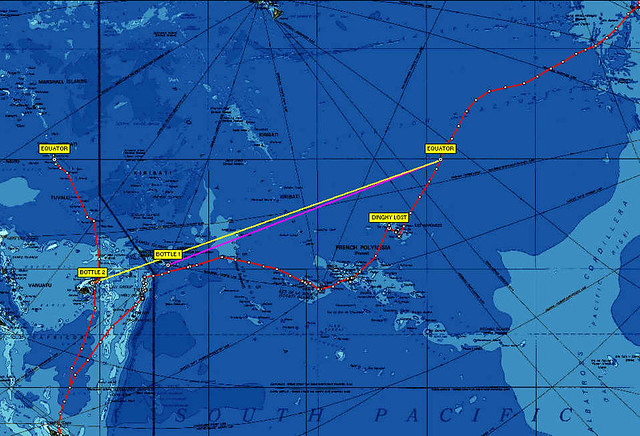| Navatu Bay : Bottle 2 destination - 3000 Miles and ended up 15 miles away from our entrance track |
 |
| Our track vs the two recovered bottles |
As we were getting ready for our 5 year sailing trip, we decided to have a party to say goodbye to all of our friends and family. The boat was very full and we were slightly afraid of the “helpful” gifts we might receive from the guests, so we stole an idea from our friends on Claire de Lune who had left earlier in the season. In lieu of gifts, it was suggested that guests bring a bottle of wine with their email and/or mailing address on the bottle. We told them that we would email/mail them from the location we drank their bottle of wine and describe some of our adventures of the area. It is not much of a bribe but I guess there are a few people who want to live vicariously through other people's drinking habits, and we left Ventura CA with a full wine-bilge.
As we set out on the big puddle-jump between Puerto Vallarta Mexico and the Marquesas we decided to add a little bonus for our adventure starved friends. On April 12 at the equator (133° W) we threw four wines bottles overboard with messages and our boat cards wrapped inside ziplock bags into the great blue ocean to see what would happen. We continued across the South Pacific on the traditional coconut milk run route (the northern version) and ended up in New Zealand in November 2004, having traveled over 9000 nautical miles since our going away party the year before.
In early January we received an email from a woman in Auasi, American Samoa whose son had found one of our bottles on the beach on Dec 31, 2004. She said the message was unreadable, but our boat card helped guide her to us. Our bottle had traveled 2400 nautical miles during our passage and ended up within 50 miles of our track between Suwarrow in the Cook Islands and Nuiatoputapu in Tonga.
We spent the rest of cyclone season enjoying the land travel in New Zealand covering almost the same distance as our pacific crossing, before we headed back to the tropics to Savusavu Fiji in May, 2005. We spent most of our time in Fiji off the beaten track, cruising the eastern side of Fiji to the Lau group, Budd Reef and the Northern side of Vanua Levu and did not see more than four other boats the entire time. We were very much looking forward to stocking up on some fresh produce when we arrived in Labasa Fiji, where we checked our email and were amazed to find that another one of our bottles had been found. This one was found in May 2005 and on the island of Navatu in Fiji. It took us awhile but we finally located the island; it was only 15 miles from where we entered the reef in Savusavu!! We changed our plans and continued our trip around Vanua Levu and pulled into the anchorage at Navatu only to find out that the young man actually lived in Suva but was visiting his Great Aunt when he found the bottle. It was still interesting to see the village, meet his aunt and converge on the same path that our bottle had taken from over 3000 miles away.
For the cyclone season this year we are heading to the Marshall islands. We’ve really enjoyed the leisurely cruising through Tuvalu and Kirabati and yesterday, November 12, 2005, we once again found ourselves crossing the equator (this time at 173.5° E). Four more bottles entered the strong westerly setting Equatorial current and it will be VERY interesting to see where they end up. I am still amazed that two out of the four original bottles were found in one piece. When you look at the expanse of the pacific as you sail across it, then explore the remote unpopulated beaches and watch the surf pound on the windward reefs, I can’t imagine what the odds makers in Vegas would do. If only we had put a message in our dinghy before it drifted out to sea forever from Ua Pou in the Marquesas, or better yet bought a lottery ticket along the way.
Continue reading " Drifting Across the South Pacific - Messages in a Bottle"...


